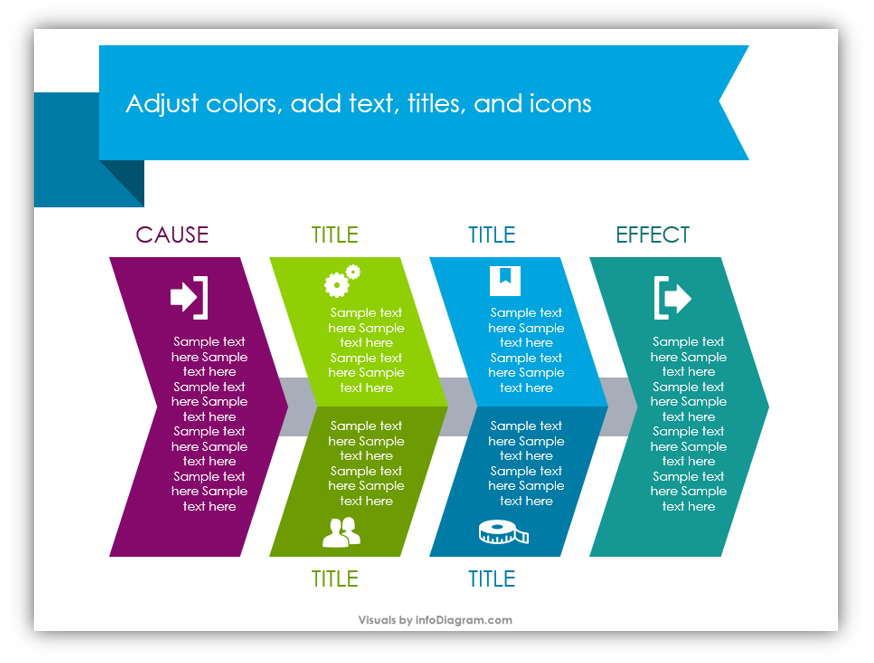
To solve any given issue successfully using the fishbone diagram, you need to define the problem correctly. Here is a guide highlighting the steps you need to take to make a fishbone diagram: Step 1: Define the issue You must be able to solve the problem to show how a fishbone diagram is made. Here is an overview of the use cases for your fishbone diagram:


Therefore, for any given system or process, the fishbone will assist you in breaking down contributing factors enhancing your problem, more so hierarchically. When to use a fishbone diagram?Īs mentioned earlier, this tool is used to solve issues, and most people find it to be more versatile. Furthermore, a fishbone diagram template is crucial because it helps you focus on ideas and experience instead of the quantitative data. After coming up with some ideas, you can put them in groupings to find out the root cause of the problem. It enables you and your team to find a more efficient solution.
#ISHIKAWA DIAGRAM TEMPLATE POWERPOINT PLUS#
Here, the detailed process is covered, and it explains more on why you decided to use the fishbone diagram template plus the requirements, such as laws, regulations, policies, rules, and procedures.Ī fishbone diagram template is used to determine the potential cause of a particular problem. These are individuals involved in the entire process These are equipment, tools, or computer used to fulfill the job as well as the task. This refers to the data produced from the process for quality evaluations. These refer to the culture, temperature, location, time, and conditions in which the entire process functions. These are the parts, including raw materials such as the pen and paper you use to generate your final product. Bear in mind that the cause is divided into key categories to allow you to recognize any variation causes and sources.

Similarly, it also allows you to focus on the history and symptoms of this problem.įurthermore, this diagram usually determines the factors leading to a primary effect, especially in product design and quality defect prevention. It enables you to focus on why the issue occurred. Thus, after finding the problem and get rid of it. It also narrows down to the factors that result in these problems. The primary goal of this diagram is to determine the entire potential cause of the issues. The reason behind the introduction of this diagram is to enhance the quality management process, more so in the Kawasaki shipyards.ĭue to the application process and its popularity, Kaoru Ishikawa becomes the modern management founding father. Kaoru Ishikawa was the first person to introduce this diagram in 1968, hence the name Ishikawa diagram. Whenever you have a problem, you can always use it to brainstorm your problems. As mentioned earlier, it is also called the cause-and-effect diagram or Ishikawa. It is showing factors of Equipment, Process, People, Materials, Environment and Management, all affecting the overall problem.A fishbone diagram is a simple tool you can use to find a corrective measure to find the root cause. Slide 2, The 8 Ps (used in marketing industry).Ĩ Ps is including Product/Service, Price, Place, Promotion, People/personnel, Process, Physical Evidence, and Packaging. Slide 1, The 5 Ms (used in manufacturing industry).ĥ Ms is including Machine (technology), Method (process), Material (Includes Raw Material, Consumables and Information), Mind Power (brain work), and Measurement/Medium (Inspection, Environment) The Fishbone Diagrams Template includes three slides.

Cause-and-effect diagrams can reveal key relationships among various variables, and the possible causes provide additional insight into process behavior. Ishikawa diagrams (also called fishbone diagrams, herringbone diagrams, cause-and-effect diagrams, or Fishikawa) are causal diagrams created by Kaoru Ishikawa (1968) that show the causes of a specific event.


 0 kommentar(er)
0 kommentar(er)
